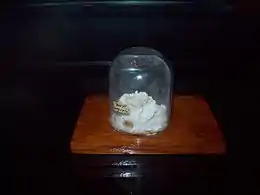Goslarite
Goslarite is a hydrated zinc sulfate mineral (ZnSO4 • 7H2O) which was first found in the Rammelsberg mine, Goslar, Harz, Germany. It was described in 1847. Goslarite belongs to the epsomite group which also includes epsomite (MgSO4 • 7H2O) and morenosite (NiSO4 • 7H2O). Goslarite is an unstable mineral at the surface and will dehydrate to other minerals like bianchite (ZnSO4 • 6H2O), boyleite (ZnSO4 • 4H2O) and gunningite (ZnSO4 • H2O).
| Goslarite | |
|---|---|
 Goslarite on display at the Museo Nacional de Ciencias Naturales | |
| General | |
| Category | Sulfate mineral |
| Formula (repeating unit) | ZnSO4 • 7H2O |
| Strunz classification | 7.CB.40 |
| Crystal system | Orthorhombic |
| Crystal class | Disphenoidal (222) (same H-M symbol) |
| Space group | P212121 |
| Unit cell | a = 11.8176 Å, b = 12.0755 Å c = 6.827 Å, Z = 4 |
| Identification | |
| Formula mass | 287.56 g/mol |
| Color | Colorless, pinkish, white, greenish, green, blue, green blue, bluish and brownish |
| Crystal habit | Acicular, massive, stalactitic |
| Cleavage | {010} perfect |
| Fracture | Conchoidal |
| Tenacity | Brittle |
| Mohs scale hardness | 2.0–2.5 |
| Luster | Vitreous (glassy) |
| Streak | White |
| Specific gravity | 1.96 |
| Optical properties | Biaxial (-) |
| Refractive index | nα = 1.447 - 1.463 nβ = 1.475 - 1.480 nγ = 1.470 - 1.485 |
| Birefringence | δ = 0.0220–0.0230 |
| Pleochroism | none |
| 2V angle | 46° |
| References | [1][2][3][4] |
Physical properties
The composition of goslarite was determined by the US National Bureau of Standards (now the National Institute of Standards and Technology) in 1959 as follows: SO3 27.84 wt%, ZnO 28.30 wt% and H
2O 43.86 wt%.
Goslarite's cleavage is perfect in {010}, as for epsomite and morenosite. The color of goslarite ranges from brownish to pinkish, blue, brown, colorless, green and green blue. The luster ranges from vitreous to nacreous and silky (if fibrous). Goslarite is soluble in water, has an astringent taste, and is strongly diamagnetic.[5][6][7]
Geologic occurrence
Goslarite is formed from the oxidation of sphalerite ((Zn, Fe)S).[8] It was first found in Rammelsberg mine, Goslar, Harz, Germany. It often occurs as an efflorescence on timbers and walls of mine passages. Goslarite is widespread as a post mining efflorescence in mines that contain sphalerite or any zinc minerals.
Economical uses
In the pharmaceutical industry it is used as a direct emetic, antiseptic and disinfectant.[9]
References
- Anthony, John W.; Bideaux, Richard A.; Bladh, Kenneth W.; Nichols, Monte C. (eds.). "goslarite". Handbook of Mineralogy (PDF). Chantilly, VA, US: Mineralogical Society of America. ISBN 0962209716.
- Goslarite on Mindat
- Goslarite data on Webmineral
- Hurlbut, Cornelius S.; Klein, Cornelis, 1985, Manual of Mineralogy, 20th ed., ISBN 0-471-80580-7
- Dana, J.D. (1854). A System of Mineralogy Comprising The Most Recent Discoveries. New York: Putnam. p. 384.
- Egleston, T (1871). Catalogue of Minerals, with Their Formulae and Crystalline Systems: Prepared for the Use of the Students of the School of Mines, of Columbia College. Columbia: Angell. p. 173.
- Palache (1944). The System of Mineralogy. New York: John Wiley & Sons. pp. 513–516.
- Gaines, RV (1997). Dana's New Mineralogy. New York: John Wiley & Sons. p. 819. ISBN 0471193100.
- Carretero, MI; Pozo, Manuel (2009). "Clay and non-clay minerals in the pharmaceutical and cosmetic industries Part II. Active ingredients". Applied Clay Science. 47 (3–4): 171–181. doi:10.1016/j.clay.2009.10.016.